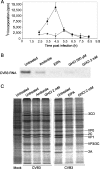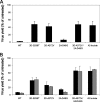Amiloride derivatives inhibit coxsackievirus B3 RNA replication
- PMID: 18032495
- PMCID: PMC2224459
- DOI: 10.1128/JVI.01374-07
Amiloride derivatives inhibit coxsackievirus B3 RNA replication
Abstract
Amiloride derivatives are known blockers of the cellular Na(+)/H(+) exchanger and the epithelial Na(+) channel. More recent studies demonstrate that they also inhibit ion channels formed by a number of viral proteins. We previously reported that 5-(N-ethyl-N-isopropyl)amiloride (EIPA) modestly inhibits intracellular replication and, to a larger extent, release of human rhinovirus 2 (HRV2) (E. V. Gazina, D. N. Harrison, M. Jefferies, H. Tan, D. Williams, D. A. Anderson and S. Petrou, Antiviral Res. 67:98-106, 2005). Here, we demonstrate that amiloride and EIPA strongly inhibit coxsackievirus B3 (CVB3) RNA replication and do not inhibit CVB3 release, in contrast to our previous findings on HRV2. Passaging of plasmid-derived CVB3 in the presence of amiloride generated mutant viruses with amino acid substitutions in position 299 or 372 of the CVB3 polymerase. Introduction of either of these mutations into the CVB3 plasmid produced resistance to amiloride and EIPA, suggesting that they act as inhibitors of CVB3 polymerase, a novel mechanism of antiviral activity for these compounds.
Figures






Similar articles
-
Amiloride is a competitive inhibitor of coxsackievirus B3 RNA polymerase.J Virol. 2011 Oct;85(19):10364-74. doi: 10.1128/JVI.05022-11. Epub 2011 Jul 27. J Virol. 2011. PMID: 21795353 Free PMC article.
-
Amiloride inhibits the initiation of Coxsackievirus and poliovirus RNA replication by inhibiting VPg uridylylation.Virology. 2014 Sep;464-465:87-97. doi: 10.1016/j.virol.2014.06.025. Epub 2014 Jul 22. Virology. 2014. PMID: 25058507 Free PMC article.
-
Pyrrolidine dithiocarbamate reduces coxsackievirus B3 replication through inhibition of the ubiquitin-proteasome pathway.J Virol. 2005 Jul;79(13):8014-23. doi: 10.1128/JVI.79.13.8014-8023.2005. J Virol. 2005. PMID: 15956547 Free PMC article.
-
Inhibition of RNA Helicase Activity Prevents Coxsackievirus B3-Induced Myocarditis in Human iPS Cardiomyocytes.Int J Mol Sci. 2020 Apr 25;21(9):3041. doi: 10.3390/ijms21093041. Int J Mol Sci. 2020. PMID: 32344926 Free PMC article.
-
Viral targets of acylguanidines.Drug Discov Today. 2012 Sep;17(17-18):1039-43. doi: 10.1016/j.drudis.2012.05.002. Epub 2012 May 8. Drug Discov Today. 2012. PMID: 22580299 Free PMC article. Review.
Cited by
-
Host-Directed Antiviral Therapy.Clin Microbiol Rev. 2020 May 13;33(3):e00168-19. doi: 10.1128/CMR.00168-19. Print 2020 Jun 17. Clin Microbiol Rev. 2020. PMID: 32404434 Free PMC article. Review.
-
Mutations in the nonstructural protein 3A confer resistance to the novel enterovirus replication inhibitor TTP-8307.Antimicrob Agents Chemother. 2009 May;53(5):1850-7. doi: 10.1128/AAC.00934-08. Epub 2009 Feb 23. Antimicrob Agents Chemother. 2009. PMID: 19237651 Free PMC article.
-
Antiviral effect of amiloride on replication of foot and mouth disease virus in cell culture.Microb Pathog. 2019 Oct;135:103638. doi: 10.1016/j.micpath.2019.103638. Epub 2019 Jul 19. Microb Pathog. 2019. PMID: 31326561 Free PMC article.
-
Amiloride is a competitive inhibitor of coxsackievirus B3 RNA polymerase.J Virol. 2011 Oct;85(19):10364-74. doi: 10.1128/JVI.05022-11. Epub 2011 Jul 27. J Virol. 2011. PMID: 21795353 Free PMC article.
-
Human rhinovirus 14 enters rhabdomyosarcoma cells expressing icam-1 by a clathrin-, caveolin-, and flotillin-independent pathway.J Virol. 2010 Apr;84(8):3984-92. doi: 10.1128/JVI.01693-09. Epub 2010 Feb 3. J Virol. 2010. PMID: 20130060 Free PMC article.
References
-
- Bedard, K. M., and B. L. Semler. 2004. Regulation of picornavirus gene expression. Microbes Infect. 6702-713. - PubMed
-
- Caliguiri, L. A., and I. Tamm. 1968. Action of guanidine on the replication of poliovirus RNA. Virology 35408-417. - PubMed
-
- Caliguiri, L. A., and I. Tamm. 1968. Distribution and translation of poliovirus RNA in guanidine-treated cells. Virology 36223-231. - PubMed
-
- Carthy, C. M., B. Yanagawa, H. Luo, D. J. Granville, D. Yang, P. Cheung, C. Cheung, M. Esfandiarei, C. M. Rudin, C. B. Thompson, D. W. Hunt, and B. M. McManus. 2003. Bcl-2 and Bcl-xL overexpression inhibits cytochrome c release, activation of multiple caspases, and virus release following coxsackievirus B3 infection. Virology 313147-157. - PubMed
Publication types
MeSH terms
Substances
LinkOut - more resources
Full Text Sources
Other Literature Sources

